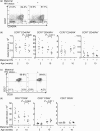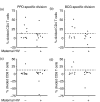Human immunodeficiency virus (HIV) infection during pregnancy induces CD4 T-cell differentiation and modulates responses to Bacille Calmette-Guérin (BCG) vaccine in HIV-uninfected infants
- PMID: 20002789
- PMCID: PMC2826689
- DOI: 10.1111/j.1365-2567.2009.03186.x
Human immunodeficiency virus (HIV) infection during pregnancy induces CD4 T-cell differentiation and modulates responses to Bacille Calmette-Guérin (BCG) vaccine in HIV-uninfected infants
Abstract
Human immunodeficiency virus (HIV)-negative infants born to HIV-positive mothers frequently exhibit a range of immunological abnormalities. We tested the hypothesis that HIV during pregnancy affects the ability of CD4 T cells of HIV-negative infants to respond to vaccine challenge by recruiting HIV-negative infants born to HIV-negative and HIV-positive mothers and measuring their responses to Bacille Calmette-Guérin (BCG) vaccine given at birth. At 2 weeks, maternal HIV status did not influence CD4 T-cell counts or differentiation, but by 10 weeks CD4 counts of infants born to HIV-positive mothers fell to a level characteristic of HIV-positive infants. Among the CD4 T-cell populations, markers of differentiation (CCR7(-) CD45RA(-) CD27(-)) and senescence (CD57, PD-1) were more common among infants born to HIV-positive mothers than among infants born to HIV-negative mothers. At 2 weeks of age, we assessed the effector response to heat-killed BCG and tuberculin purified protein derivative (PPD) by overnight interferon (IFN)-gamma enzyme-linked immunosorbent spot-forming cell assay (ELISpot), but found no measurable effect of maternal HIV status. At 10 weeks, we assessed CD4 T-cell memory by measuring proliferation in response to the same antigens. We observed a bimodal response that allowed infants to be classified as high or low responders and found that fewer infants born to HIV-positive mothers were able to mount a robust proliferative response, suggesting that their reduced CD4 counts and increased differentiation indicated a deficiency in their ability to develop immunological memory.
Figures




Similar articles
-
The impact of HIV exposure and maternal Mycobacterium tuberculosis infection on infant immune responses to bacille Calmette-Guérin vaccination.AIDS. 2015 Jan 14;29(2):155-65. doi: 10.1097/QAD.0000000000000536. AIDS. 2015. PMID: 25535752 Free PMC article.
-
Dendritic cells induce CD4+ and CD8+ T-cell responses to Mycobacterium bovis and M. avium antigens in Bacille Calmette Guérin vaccinated and nonvaccinated cattle.Scand J Immunol. 2000 Sep;52(3):285-91. doi: 10.1046/j.1365-3083.2000.00780.x. Scand J Immunol. 2000. PMID: 10972905
-
Gamma interferon production in response to Mycobacterium bovis BCG and Mycobacterium tuberculosis antigens in infants born to human immunodeficiency virus-infected mothers.Clin Vaccine Immunol. 2006 Feb;13(2):246-52. doi: 10.1128/CVI.13.2.246-252.2006. Clin Vaccine Immunol. 2006. PMID: 16467333 Free PMC article.
-
Is interferon-gamma the right marker for bacille Calmette-Guérin-induced immune protection? The missing link in our understanding of tuberculosis immunology.Clin Exp Immunol. 2012 Sep;169(3):213-9. doi: 10.1111/j.1365-2249.2012.04614.x. Clin Exp Immunol. 2012. PMID: 22861360 Free PMC article. Review.
-
Immunophenotyping of T cell subpopulations in HIV disease.Curr Protoc Immunol. 2005 Mar;Chapter 12:Unit 12.12. doi: 10.1002/0471142735.im1212s65. Curr Protoc Immunol. 2005. PMID: 18432939 Review.
Cited by
-
Analysis of the TCR Repertoire in HIV-Exposed but Uninfected Infants.Sci Rep. 2019 Aug 16;9(1):11954. doi: 10.1038/s41598-019-48434-4. Sci Rep. 2019. PMID: 31420576 Free PMC article. Clinical Trial.
-
The Effect of Human Immunodeficiency Virus and Cytomegalovirus Infection on Infant Responses to Vaccines: A Review.Front Immunol. 2018 Mar 2;9:328. doi: 10.3389/fimmu.2018.00328. eCollection 2018. Front Immunol. 2018. PMID: 29552009 Free PMC article. Review.
-
Fetal exposure to HIV-1 alters chemokine receptor expression by CD4+T cells and increases susceptibility to HIV-1.Sci Rep. 2014 Oct 24;4:6690. doi: 10.1038/srep06690. Sci Rep. 2014. PMID: 25341640 Free PMC article.
-
In-utero exposure to maternal HIV infection alters T-cell immune responses to vaccination in HIV-uninfected infants.AIDS. 2014 Jun 19;28(10):1421-30. doi: 10.1097/QAD.0000000000000292. AIDS. 2014. PMID: 24785950 Free PMC article.
-
The Immune System of HIV-Exposed Uninfected Infants.Front Immunol. 2016 Sep 28;7:383. doi: 10.3389/fimmu.2016.00383. eCollection 2016. Front Immunol. 2016. PMID: 27733852 Free PMC article. Review.
References
-
- UNAIDS . AIDS Pandemic Update. Geneva, Switzerland: UNAIDS and WHO; 2006.
-
- Scarlatti G. Paediatric HIV infection. Lancet. 1996;348:863–8. - PubMed
-
- Clerici M, Saresella M, Colombo F, et al. T-lymphocyte maturation abnormalities in uninfected newborns and children with vertical exposure to HIV. Blood. 2000;96:3866–71. - PubMed
-
- Bailey R, Kamenga M, Nsuami M, Nieburg P, St Louis M. Growth of children according to maternal and child HIV, immunological and disease characteristics: a prospective cohort study in Kinshasa, Democratic Republic of Congo. Int J Epidemiol. 1999;28:532–40. - PubMed
Publication types
MeSH terms
Substances
Grants and funding
LinkOut - more resources
Full Text Sources
Medical
Research Materials

